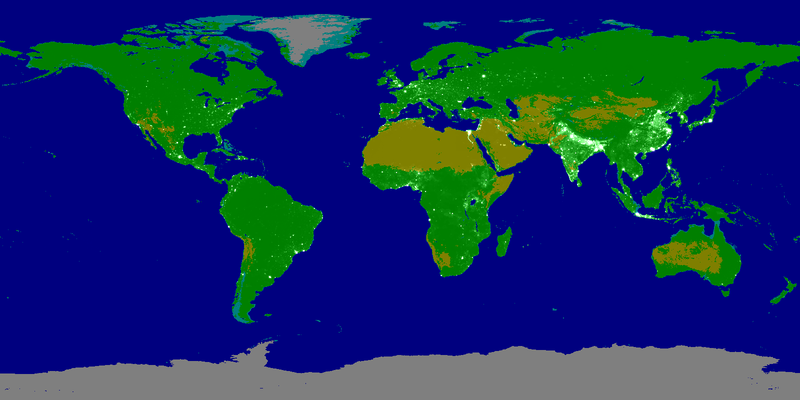File:solar-land-requirements.png

Original file (1,600 × 800 pixels, file size: 388 KB, MIME type: image/png)
Summary
World map: If all energy came from solar panels, how much land would we need?
The land is shown in white.
We would need approximately 0.8% of Earth's surface.
Just for comparison, crop land is about 2.9% of Earth's surface, and pasture land is about 5.4% of Earth's surface.
Methodology
Area required for solar panels, if
- all energy came from solar photovoltaics, and
- everyone on Earth lived a "first-world" lifestyle.
Map projection: equirectangular
- Page 49: OECD energy balance, 2018
data.worldbank.org › indicator › SP.POP.TOTL
Using data from 2020
OECD countries are: Austria, Australia, Belgium, Canada, Chile, Colombia, Costa Rica, Czech Republic, Denmark, Estonia, Finland, France, Germany, Greece, Hungary, Iceland, Ireland, Israel, Italy, Japan, Korea, Latvia, Lithuania, Luxembourg, Mexico, the Netherlands, New Zealand, Norway, Poland, Portugal, Slovak Republic, Slovenia, Spain, Sweden, Switzerland, Turkey, the United Kingdom and the United States.
https://www.newport.com/t/introduction-to-solar-radiation
http://www.ftexploring.com/solar-energy/insolation.htm
First we estimate how much energy would be needed per person: [''']this is a conservative overestimate. People in warm climates might actually need slightly less energy because they don't need heating. The difference is not a lot though (calculation loading)
Then we estimate how much area that would take (calculation loading)
Now we use that to generate an isochromic map:
Image generator code:
# load files pop << data/population.data-float64-8640x4320 earth << data/blue-marble-posterized.png # convert 'pop' to population density (people per km^2) pop @@ quantity_to_density # resize 'pop' to fit the 'earth' background pop :: earth.r # make 'pop' represent "for each pixel, what fraction of the land is solar land" pop *= 0.00053790026 # km^2 per person needed for solar pop @@ spread # darken the background earth.r *= 0.5 earth.g *= 0.5 earth.b *= 0.5 # show the solar land in white earth.r += pop earth.g += pop earth.b += pop earth.r <= 1 earth.g <= 1 earth.b <= 1 # save earth >> data/solar-land-requirements.png # How much solar land is needed in total? pop @@ density_to_quantity # make 'pop' represent "for each pixel, how many km^2 of solar land" pop @@ stats
From the "stats" output from the last line:
Sum: 4293152.303951
This means there is 4293152 km^2 of solar land.
Divide this by the Earth's surface (510072000 km^2), and you get 0.8%.
Would your city need solar farms?
(calculation loading)
Simple heuristic:
- If your city's population density is greater than this number above, then yes.
- Otherwise, all energy could be generated within the city (rooftops, probably).
But this is an oversimplification. Some things to consider:
- Every city defines its borders differently - this could bias the official stats of "population density".
- If factories are in some industrial area outside the city, their solar panels could be there instead.
- Other factors, shown in the next section:
Limitations of this analysis
- Not all cities have the same
area_suitedfor solar panels. - Solar panel output varies by latitude.
- Energy requirements for heating depend on latitude.
If we want something really accurate, we might have to analyze things on a city-by-city basis.
Not counted in this map: The land that would be needed for extracting the mineralsyou can help calculate this - analyze your favorite battery chemistry and solar panel chemistry needed to make both the solar panels and energy storage.
File history
Click on a date/time to view the file as it appeared at that time.
| Date/Time | Thumbnail | Dimensions | User | Comment | |
|---|---|---|---|---|---|
| current | 02:59, 7 August 2022 |  | 1,600 × 800 (388 KB) | Elie (talk | contribs) | World map: If all energy came from solar panels, how much land would we need? The land is shown in white. We would need approximately 0.8% of Earth's surface. <small>Just for comparison, crop land is about 2.9% of Earth's surface, and pasture land is about 5.4% of Earth's surface.</small> ==Methodology== Land required for solar panels, if * all energy came from solar photovoltaics, and * everyone on Earth lived a "first-world" lifestyle. Map projection: equirectangular Not counted in... |
You cannot overwrite this file.
File usage
The following page uses this file:
- File:Solar-land-requirements.png (file redirect)